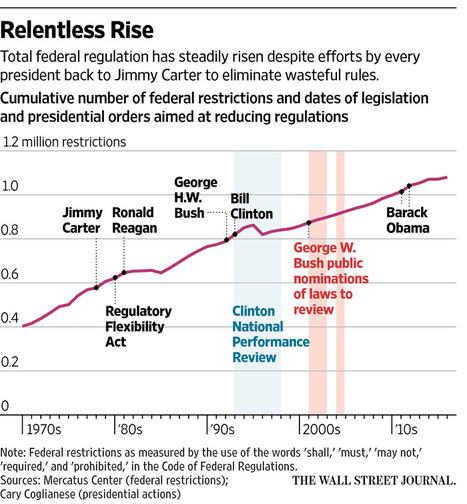(p. B1) More than any other president since Ronald Reagan, President Trump is moving to strip away regulations and slash taxes, said Jeffrey Korzenik, an investment strategist with Fifth Third, a large regional bank in the Midwest and Southeast. In meetings with clients, Mr. Korzenik has been making the case that these policies will rouse the slumbering animal spirits in businesses across America.
“And now we have seen this huge spike in small-business confidence since the election,” Mr. Korzenik said, pointing to a chart. “So I have to ask you: Do you feel more confident now?”
There was a moment of silence, broken only by a howling northwestern Ohio wind that rattled the floor-to-ceiling windows in the bank’s boardroom.
Then, with rapid-fire speed, came the responses.
The president of a trucking company spoke of a “tremendous dark cloud” lifting when he realized he would no longer be feeling the burden of rules and regulations imposed by the Obama administration.
The owner of an automotive parts assembler gave thanks that he would not be receiving visits from pesky envi-(p. B3)ronmental and workplace overseers.
And the head of a seating manufacturer expressed hope that, finally, his health care costs would come down when the Affordable Care Act was repealed.
“My gut just feels better,” said Bob Fleisher, president of a local car dealership. “With Obama, you felt it was personal — like he just didn’t want you to make money. Now we have a guy who is cutting regulations and taxes. And when I see my taxes going down every quarter — well, that means I am going to start investing again.”
. . .
A heavier regulatory burden and uncertainty born of a weak economic recovery have kept small-business owners from making big bets in investments or hiring.
But in Toledo, this reluctance is changing — and quickly.
Louis M. Soltis owns a small company that manufactures control panels for large factories and machines. After four years of not adding to his work force of 22, he has seen orders for panels jump in the last two months and is looking to take on as many as six new workers.
There may not be a direct correlation between his surging order book and the new president, but there is no doubting the psychological boost.
“That guy is a junkyard dog, doing his tweets at 3 a.m. and taking on the news media — I just get strength from him,” Mr. Soltis said over a wine-soaked dinner with a large group of his small-business friends and peers from around town. “And I have to say, it makes you feel gutsy — ready to step up and start investing again.”
. . .
Yet there is a downside to animal spirits that persist too long, especially in labor markets, like Toledo’s, that are operating on the tight side.
And that is a sharp uptick in inflation.
In his presentation to Fifth Third’s banking clients, Mr. Korzenik raised this issue, suggesting that the broader economy was in the “seventh inning” of what has been a pretty long business cycle.
. . .
Still, no one in the room seemed overly concerned. As the group saw it, the party was just beginning.
“Most businesses I know are just taking a deep breath, happy that there is finally someone in the White House who understands what they do,” said Mr. Fleisher, the owner of the Lincoln car dealership. “So you say we are in the seventh inning — well, I am not sure we are.”
For the full story, see:
LANDON THOMAS Jr. “Small Businesses’ Hopes Are Up.” The New York Times (Mon., MARCH 13, 2017): B1 & B3.
(Note: ellipses added.)
(Note: the online version of the story has the date MARCH 12, 2017, and has the title “The President Changed. So Has Small Businesses’ Confidence.”)

